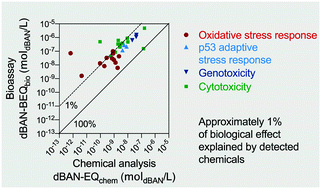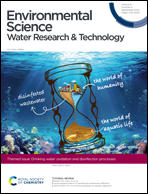Mixture effects of drinking water disinfection by-products: implications for risk assessment†
Abstract
Disinfection by-products (DBPs) in drinking water have been associated with increased cancer risk but single DBPs cannot explain epidemiological cancer occurrences. To test if combined effects of DBPs are plausible to explain epidemiological evidence for adverse health effects, we assessed if mixture effects of DBPs can be predicted using the concentration addition (CA) model. We prepared 12 mixtures of DBPs (trihalomethanes, halonitromethanes, haloacetonitriles, haloketones, haloacetic acids, chloral hydrate, haloacetamides, 3-chloro-4-(dichloromethyl)-5-hydroxy-5H-furan-2-one (MX)) in equipotent concentration ratios. We determined effect concentrations with three reporter gene bioassays (AREc32, ARE-bla, and p53-bla) based on human cell lines and one bacterial assay (Microtox). The experimental effect concentrations agreed well with the effect concentrations predicted with the CA model, which suggests that the CA model is applicable for reactive DBPs despite different molecular mechanisms because the reporter gene assays are only detecting one mechanism each. Modelling of mixture effects of DBPs in ratios detected in drinking water revealed that haloacetonitriles, haloketones, and mono-haloacetic acids contributed the most to the total effect indicating a higher health relevance of these DBP groups. In drinking water samples the sum of the detected DBPs explained <6% of effect in most cases. The CA model could be applied to prioritize DBPs for further risk assessments to potentially close the gap between toxicological cancer risk predictions and epidemiological findings.



 Please wait while we load your content...
Please wait while we load your content...